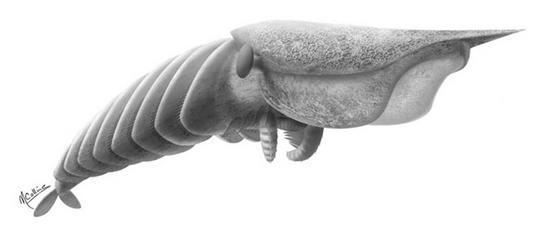500 million year old predator monster
Hurdia victoria was described as a crustacean. Uppsala University researchers and other colleagues say the trait is only part of this complex and unusual animal. This animal itself contains the story of the origin of the largest group of animals, arthropods.
Fossil fragments originate from the famous Burgess Shale area of 505 million years old, a world heritage site recognized by UNESCO, in British Columbia, Canada. Allison Daley and Graham Budd of the Department of Earth Sciences, Uppsala University, along with colleagues in Canada and the United Kingdom, describe the complex history and special body structure of Hurdia Vicotria, the creepy predator into its time.
The first pieces of fossils were collected more than 100 years ago and are believed to be part of crustaceans. However, no one realized that other parts of this animal were also included in the fossil collection, but were described separately as jellyfish, sea cucumbers and other arthropods. However, by synthesizing expeditions from the 1990s, more complete specimens and hundreds of separate fossils were given light, and the first clue that Hurdia was not a single animal. as simple as previous thoughts. The final piece of the problem was found when a very well preserved specimen appeared in the collection at the Smithsonian National Museum of Natural History, Washington. This specimen was categorized as arthropods from the 1970s and 1980s, after which it was identified as a common specimen of a famous predator, Anomalocaris.
 Illustration Hurdia Victoria. (Photo: Mariane Collins)
Illustration Hurdia Victoria. (Photo: Mariane Collins)
Hurdia's new description shows that it is a relative of Anomalocaris. Like Anomalocaris, Hurdia has a body that is divided into many parts with the head having two prickly claws and an arched jaw structure with lots of teeth. However, the difference was that the Hurdia possessed a three-part apricot layer in front of the head.
"This structure is not the same as any fossil or arthropod that exists today," said PhD student Alllison Daley, who studied these fossils for three years .
'This tomorrow's function is still a mystery. In many animals, shells or shells are used to protect the body's software, like crabs or shrimp, but this structure in Hurdia is completely empty and does not cover or protect the rest of the body. In this respect, we can only predict '.
Hurdia and Anomalocaris are one of the first ancestors of an evolutionary lineage that leads to arthropods, a group of modern animals including insects, crustaceans, spiders, and polyhedra. They show the origin of the important properties of modern arthropods, such as head structures and limbs. Similar to the strange tomorrow class at the beginning, Hurdia possesses a complex bearing system attached to the body.
Allison Daley said: 'The system carries around the body to provide enough oxygen for such large animals'.
Refer:
Allison Daley, Graham Budd, Jean-Bernard Caron, Gregory Edgecombe and Desmond Collins.The Burgess Shale anomalocaridid Hurdia and its significance for early euarthropod evolution.Science, 20th March 2009
- The constant debate about the 300 million-year-old Tully monster
- Legend of the 'water monster' Da river
- The 70-million-year-old plesiosaur fossil resembles the Loch Ness monster
- Detection of 180 million year old sea monster fossils
- The mysteries of Pacific Cthulhu
- Digging the 250 million year old sea monster in the American desert
- Loch Ness monster monster objects head up on the lake
- Discovering fossils of 250 million-year-old sea monsters
- Catching 'cannibalism' crabs
- The North Pole monster can bite the Hummer car
- Recreate the 410 million-year-old spider's walking
- 10 most famous aquatic monsters of all time
 Discovered an ancient centipede fossil 99 million years old
Discovered an ancient centipede fossil 99 million years old Discovered bat-like dinosaurs in China
Discovered bat-like dinosaurs in China Discovered a 200-year-old bronze cannon of the coast
Discovered a 200-year-old bronze cannon of the coast Discover 305 million-year-old spider fossils
Discover 305 million-year-old spider fossils